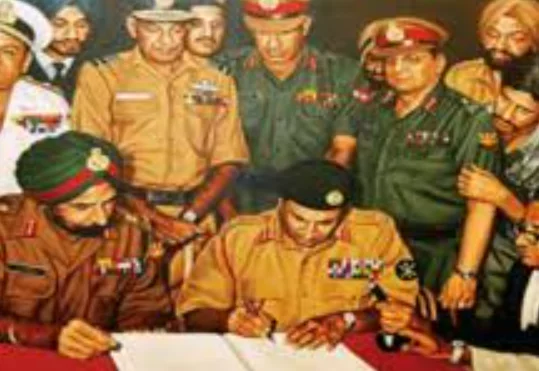In the 50 years since its independence from Pakistan, Bangladesh has moved past religion and the two nation theory.
In April 1946, Maulana Abul Kalam Azad told journalist Shorish Kashmiri in an interview, “I can only spot grave dangers in Jinnah’s demand for Pakistan. Note something else as well. Bengal has so far eluded Jinnah’s scrutiny. And he is yet to know that Bengal simply does not yield to outside dominance and authority. Bengali will protest — sooner or later. I believe East Pakistan can never put up with the supremacy of West Pakistan — the two can never co-exist. Their faiths are disparate; what else is to bind the two? The only reality of being Muslims can hardly be a cohesive factor.”
West Pakistan deprived and coerced East Pakistan in more areas than one. Jute — and other crops — cultivated in East Pakistan had their prices determined in West Pakistan; a mere half of the profits trickled back to East Pakistan. Apples, grapes or woolen garments produced in West Pakistan were sold at 10 times the price in East Pakistan. Discrimination was such that the slightest of dissent branded one an enemy of Pakistan or of Islam. Persecution, arrests, incarcerations were the order of the day.
The Pakistan Resolution was passed in Lahore, March 1940. In 1966, Opposition leaders of Pakistan got together, where the six-point programme was spearheaded by Sheikh Mujibur Rahman. It had the seeds of building a strong Pakistan and, of course, a free Bangladesh. Pakistan’s spies and military intelligence lost no time in gauging the message of secession and self-determination in the six-point programme. Communist leader Moni Singh said after the liberation: “Bangabandhu had the plan of Liberation in his mind right in 1951.”
The Awami League and Bangabandhu launched countrywide rallies in favour of the six-point programme from March 1966. The movement spread. Mujibur, along with many others, was arrested. The prison, however, could not keep them for long and they had to be freed. The Ayub Khan regime charged protesters with the Agartala Conspiracy Case. The people of East Pakistan rose as one and sought Mujibur Rahman’s release. Section 144 was imposed. Slogans soared into the air — “Jai Bangla” (Hail Bangla), “Tomar Amaar Thikana, Padma, Meghna, Jamuna” (Our home is here, do you know?/ Where the Padma-Meghna-Jamuna flow); “Dhaka Na Pindi, Dhaka, Dhaka” (Give us Dhaka, not Pindi/ Give us Dhaka every day!). No placard or slogan mentioned East Pakistan or East Bengal any longer; it was Bangladesh all the way. This author, too, penned a couple of such slogans.
On March 7, Bangabandhu addressed the nation. He made it clear: “This time the struggle is for our freedom.”
At midnight on March 25, Pakistan unleashed genocide in Bangladesh. Refugees streamed into India. India stood by Bangladesh in its freedom struggle and one must salute the contribution of Indira Gandhi – as well as of the Indian Army — in winning liberation for Bangladesh.
As the genocide began on the night of March 25-26 is commemorated as the day of liberation. The Pakistani supremacy lasted two and a half decades — religion and the two-nation theory fell on the way.
Just eight months into Pakistan’s existence, Jinnah had arrived in Dhaka and addressed two rallies. He declared Urdu the state language of West and East Pakistan. He forgot that the people of East Pakistan did not speak Urdu — they spoke Bangla. The seeds of the Bangla Language Movement — as well as the Bangladesh Liberation War — could be traced to Jinnah’s proclamation.
I met a Pakistani novelist in London who said, in jest, “both Pakistan and Bangladesh owe their births to Jinnah. A common religion cannot unite countries and nations. Despite his wisdom and astuteness as a politician he was blind to this issue.”
The Constitution of Bangladesh had four main principles — democracy, socialism, secularism and Bengali nationalism. However, all four have disappeared after the assassination of Bangabandhu. Democracy remains, in name only. Elections take place though.
That tradition continues. Sheikh Hasina, daughter of Bangabandhu Mujibur Rahman, has been Prime Minister of Bangladesh for a decade. She has retained “Bismillah” and Islam as the state religion. She had pledged, before coming to office, to restore the four main principles of the Constitution, but has refrained from doing so. In fact, she leans more on Islam, Islamic countries and Islamic parties.
The history of Bangladesh’s liberation is half a century of disparate and chequered aspects. It witnessed the assassination of Bangabandhu, the reigns of two military dictators, the formation of SAARC at the initiative of Ziaur Rahman, a military coup and the assassination of Ziaur Rahman, three caretaker regimes, governments headed by two women prime ministers, the rise of nearly a hundred political parties, all mostly Islamic. The Awami League and BNP and their respective leaders — Sheikh Hasina and Begum Zia — are encumbered by the growing demands of Islamic parties. While these parties are thriving, the progressive ones are barely heard and seen.
Bangladesh is no longer a “bottomless basket”, as described by Henry Kissinger. The country’s per capita income is $2,064. Primary education now stands at nearly 98 per cent. In the 50 years, Bangladesh has moved past religion and the two-nation theory. The country glories in her freedom, in her place among world nations.




